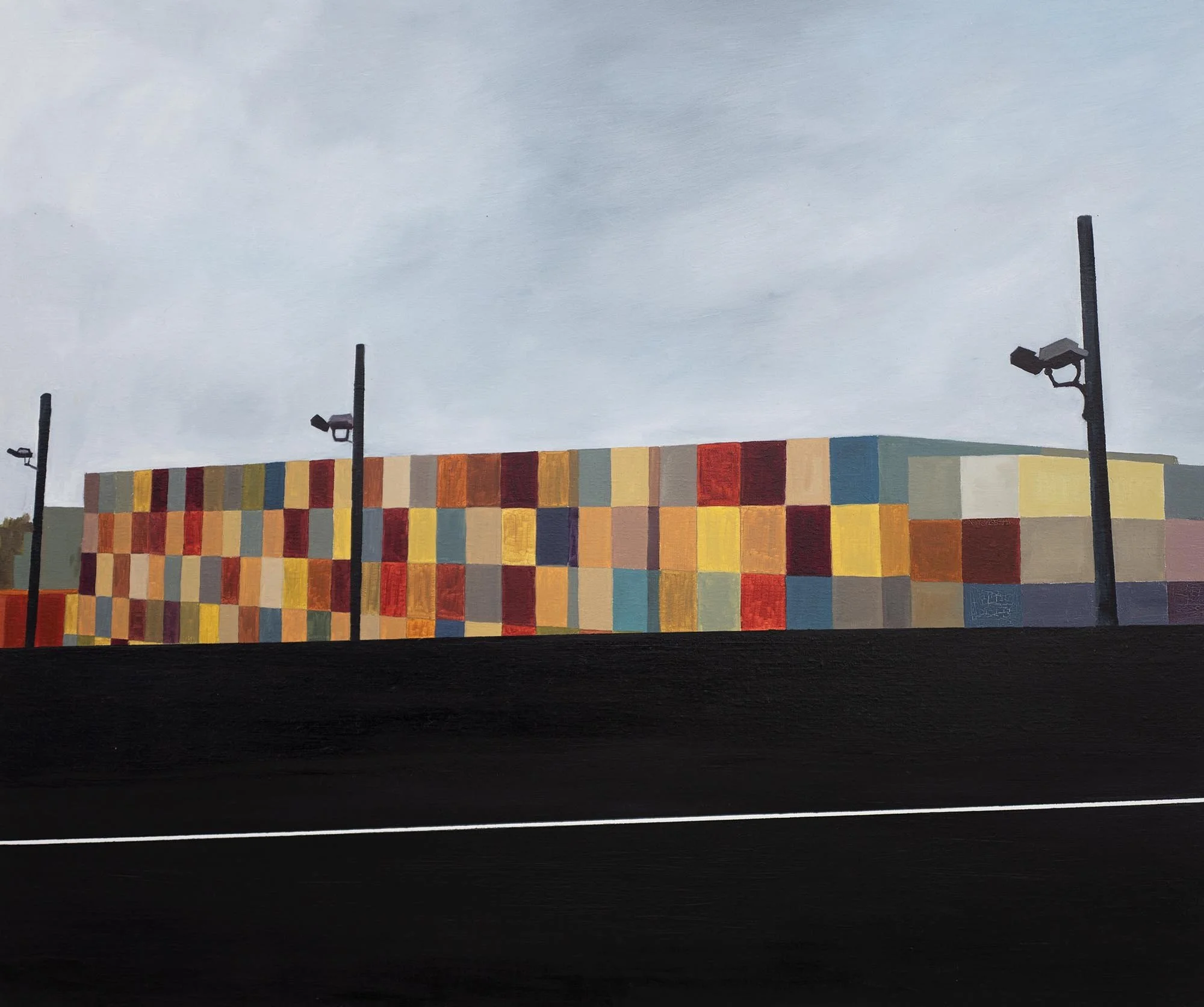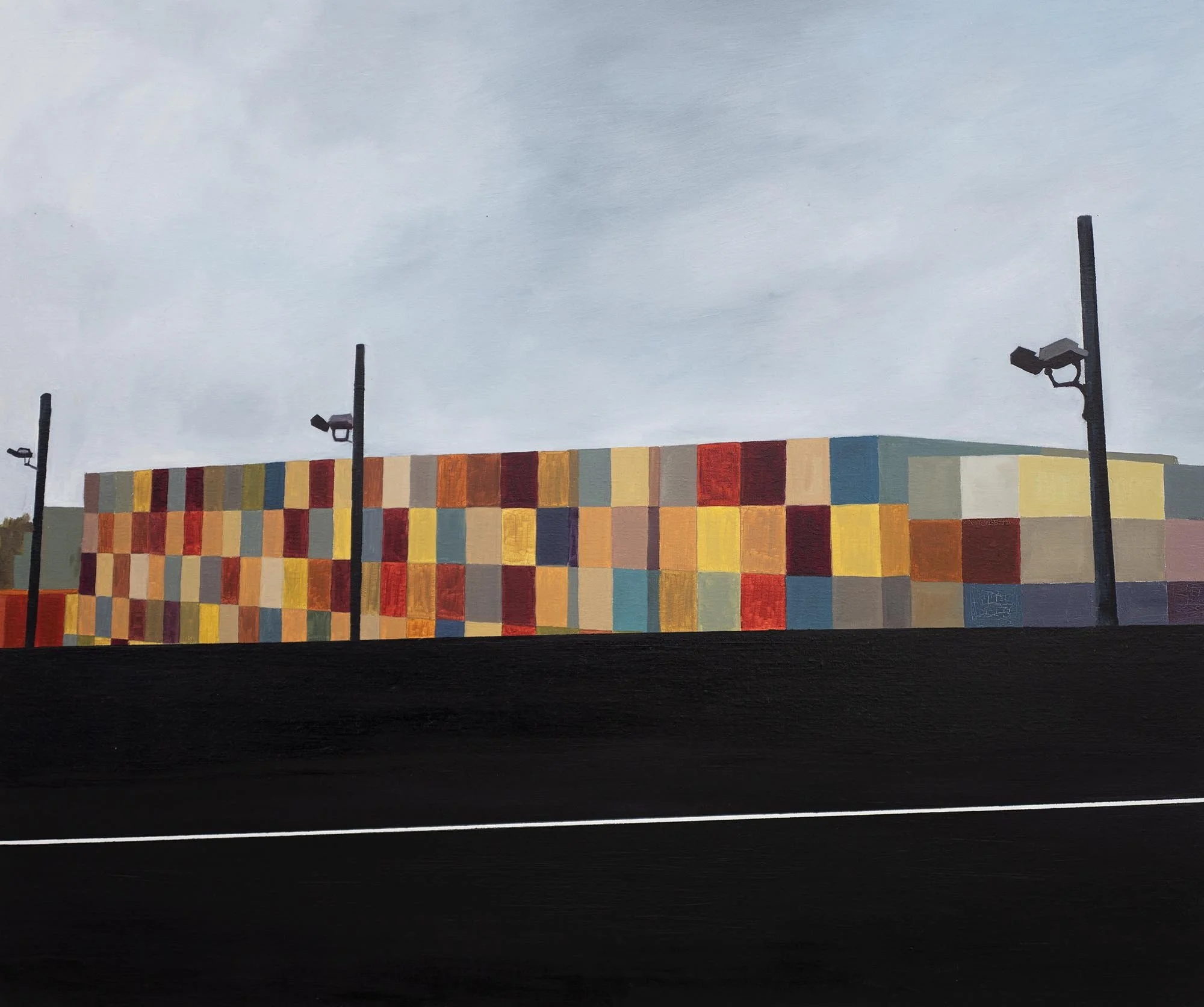Containers, 2021
Containers, 2021
Oil on linen
76 x 91 cm (30 x 36 in)
Container (2021) is a painting by Tan Mu, based on photographs taken on a New Jersey highway. Created during the COVID-19 pandemic, the artwork reflects the global supply chain and transportation slowdowns that led to widespread shortages and shifts in consumption patterns. The pandemic’s mandates and restrictions caused economic stagnation, with labor shortages leaving goods stranded at shipping ports. A global chip shortage further exacerbated the crisis, particularly in the automotive and electronics industries. The long-term effects of this crisis continue to impact food security, culminating in issues like the 2022 food crisis. These reflections prompted Tan Mu to explore the intersections of global trade, the exchange of goods, and personal memory. The multicolored shipping containers in the painting are not merely vessels for transporting items—they are carriers of information and technology. Tan Mu’s creative process began with the pandemic’s impact on global trade and gradually expanded to examine how globalization profoundly affects personal lives and emotions. These impacts manifest not only in material exchanges but also in the ways people stay connected through technology and information, forming emotional ties and sustaining cultural continuity.
Q: What prompted you to focus on this container that carries both goods and information?
Tan Mu: Yantai’s role as a port for imported goods, combined with my parents’ careers, provided me with early exposure to the world of cargo transport and container logistics. Scenes of ships being loaded and containers being dispatched became part of my childhood memories, leaving an impression that now deeply informs my artistic practice. These early experiences naturally connected to my current engagement with global logistics and information exchange. In my daily life, I often rely on maritime shipping to send art materials and other items across borders, making me not just an observer but an active participant in global trade. The inspiration for this painting arose from these personal experiences. To delve deeper, I contacted my regular shipping company for access to promotional stock images and captured my own photos of containers. The painting reflects one of these images, translating a familiar yet often overlooked aspect of my daily life into an artwork. Through this piece, I aim to explore the intricate intersections of global trade, the circulation of goods, and the preservation of personal memory. By weaving together these threads, the work not only reflects my relationship with maritime logistics but also invites broader reflections on the ways global systems shape individual experiences.
Q: Does this have a deeper connection to your personal experiences?
Tan Mu: Beyond my longstanding focus on maritime trade and transmission, I have expanded its deeper meaning through my family stories, which have deeply influenced my creative process. These stories trace back to my maternal great-grandfather, a maritime trader during the Republican era. He spent much of his life navigating international waters between China and Korea, engaged in the complex exchange of goods and culture. His journeys were disrupted by World War II, forcing him to seek refuge in Korea, where he became a part of the overseas Chinese community before eventually returning to China in later years. This transnational history not only shaped my family’s identity but also instilled in me a sensitivity to the continuous flow of cultural exchange and the interconnectedness of our world—ideas that resonate throughout my work. The experiences of my great-grandfather and the enduring legacy of his maritime ventures have guided me to explore the journey of goods and ideas that traverse the sea, reflecting on the cultural, emotional, and informational layers carried by these containers. Through my art, I delve into how these objects are not mere physical entities, but carriers of memories, histories, and connections that transcend borders and generations.
Q: What is your understanding of the information and culture carried by the container, beyond the meaning of the goods themselves?
Tan Mu: I believe that the containers loaded onto cargo ships are not just vessels for transporting goods, but also carriers of information. On one hand, the cargo they carry includes crucial items such as chips and equipment for the electronics industry. Any disruption in their movement can have a significant impact on technological development, and this became especially apparent during the pandemic, when global supply chains slowed down. The resulting halt in shipments disrupted not only the flow of goods but also the progress of technological innovation, which highlighted for me how tightly interconnected carriers are with communication, technological transformation, and societal advancement. On the other hand, these containers also symbolize emotional connections and the continuity of culture. The trade that happens through them is not just about physical exchange but also reflects how people use technology and information to maintain contact and communication with the world. This global flow of goods and information creates profound impacts on personal lives and emotions, shaping not only the material world but also how we stay connected.
The effect of this globalization is particularly striking when we consider how technology alters the way information is transmitted. This theme is closely tied to my ongoing exploration of "how to make information last for ten thousand years," in which I delve into the role of carriers in preserving information as a cultural and historical legacy. My works, particularly the Signal series, which explores undersea fiber-optic cables, take this investigation further, offering a deeper reflection on the function of containers in the transmission and preservation of information across time. My work thus becomes a meditation on how the act of trading, moving, and sharing—whether through tangible goods or intangible information—shapes our identity, our relationships, and our understanding of history.
Q: How did you approach these elements in your composition?
Tan Mu: At the forefront of the painitng is a road, a photo I took on a highway in New Jersey. This highway, as a literal and metaphorical element, reflects the concept of transmission. In the center of the painting, the colorful containers are simplified into rectangular blocks of color, their details minimized to draw the viewer's attention to the broader meaning behind this collective image. They resemble stacked hard drives, representing the metal shells that carry both goods and information. By abstracting the details, I wanted to emphasize the collective rather than individual elements, allowing the focus to shift from the containers themselves to the larger idea of what they represent—the storage and transmission of cargo and culture.



